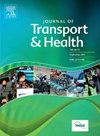Electric scooter use: The perspective of university students
IF 3.2
3区 工程技术
Q2 PUBLIC, ENVIRONMENTAL & OCCUPATIONAL HEALTH
引用次数: 0
Abstract
Introduction
E-scooters stand out as a vehicle that has the potential to support the mode shift towards more sustainable transport and to achieve greater equity in mobility. There is a need to examine the attitudes and views of various segments of society towards e-scooters to understand the impact of this new vehicle on cities and to provide various operational and safety solutions.
Methods
This study conducted a face-to-face survey focusing on revealing the perspectives of university students in nine major cities in Türkiye. A survey was carried out with a total of 1302 people, and 1211 valid questionnaires were provided for statistical analysis. Various results related to the university students' views and attitudes on e-scooter use were achieved through the binary and ordered logit models.
Results
Results principally provide the variables affecting the current and future use of e-scooters. The remarkable results are outlined as follows: (i) E-scooter use is positively affected by university students' attitudes that e-scooters are enjoyable and economical, and they offer time savings and ease of use. (ii) Short-distance and short-duration commute trips by e-scooters are embraced by university students. (iii) The risk of falling, the high fees of shared e-scooters, access problems to shared e-scooters, and aesthetic concerns are major obstacles to e-scooter use.
Conclusions
Developing all aspects of micromobility is well-known to be a critical task for a healthier and sustainable urban life. This study, which focuses on university students' perspectives on e-scooter use, can be seen as a part of this task, and the findings and discussions may be beneficial for transport infrastructure providers and policymakers.
电动滑板车使用:大学生视角
导言 电动滑板车是一种有潜力支持向更可持续的交通方式转变并实现更大的交通公平的交通工具。有必要研究社会各阶层对电动滑板车的态度和看法,以了解这种新型交通工具对城市的影响,并提供各种运营和安全解决方案。方法 本研究开展了一项面对面调查,重点揭示土耳其九个主要城市的大学生的观点。共对 1302 人进行了调查,并提供了 1211 份有效问卷用于统计分析。通过二元模型和有序对数模型,得出了与大学生对电动摩托车使用的观点和态度相关的各种结果。主要结果概述如下(i) 电子代步车的使用受到大学生态度的积极影响,他们认为电子代步车既愉快又经济,还能节省时间和方便使用。(ii) 大学生欢迎使用电动滑板车进行短途和短期通勤出行。(iii) 摔倒的风险、共享电动滑板车的高昂费用、共享电动滑板车的交通问题以及美观问题是使用电动滑板车的主要障碍。本研究侧重于大学生对电动滑板车使用的看法,可视为这项任务的一部分,研究结果和讨论可能对交通基础设施提供者和政策制定者有益。
本文章由计算机程序翻译,如有差异,请以英文原文为准。
求助全文
约1分钟内获得全文
求助全文

 求助内容:
求助内容: 应助结果提醒方式:
应助结果提醒方式:


